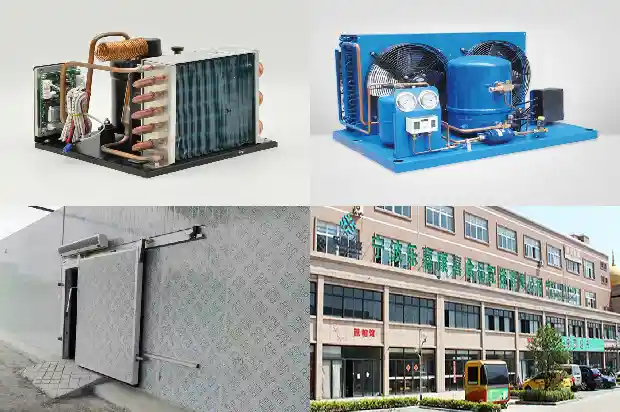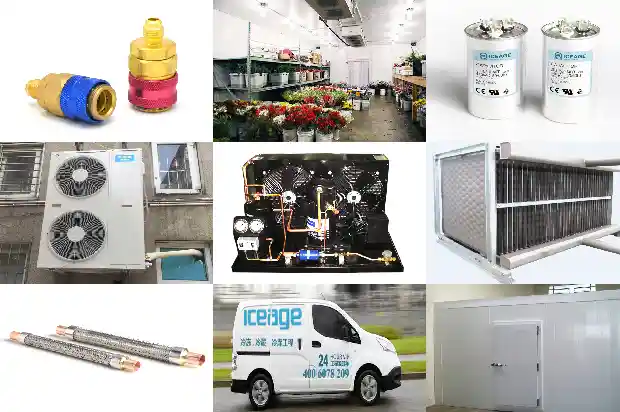Why Should Refrigerant Be Filled in Liquid Form? What Are the Filling Methods?
2024-12-30
I. Whether to Add Liquid or Gas for Refrigerant
Refrigerants can be divided into three types: single-component refrigerants, non-azeotropic mixture refrigerants, and azeotropic mixture refrigerants.
For single-component refrigerants, regardless of whether they are in gaseous or liquid states, their components will not change. Therefore, gaseous refrigerant can be charged during the charging process.
Although the components of azeotropic refrigerants are different, due to the same boiling point, the components of the gas and liquid phases are also the same. Thus, gaseous charging is possible.
For non-azeotropic refrigerants, because of the different boiling points, the components of liquid and gaseous refrigerants are actually different. At this time, if gaseous refrigerant is added, it will inevitably lead to different components of the added refrigerant. For example, only a certain gaseous refrigerant is added. Therefore, only liquid can be added.
That is to say, non-azeotropic refrigerants all need to be added in liquid form. Non-azeotropic refrigerants all start with R4, and such refrigerants need to be added in liquid form. Common non-azeotropic refrigerants include: R40, R401A, R403B, R404A, R406A, R407A, R407B, R407C, R408A, R409A, R410A, R41A.
As for other common refrigerants, such as: R134a, R22, R23, R290, R32, R500, R600a, neither adding gas nor adding liquid will affect the components of the refrigerant. So, it can be done in whichever way is more convenient.
For single-component refrigerants, regardless of whether they are in gaseous or liquid states, their components will not change. Therefore, gaseous refrigerant can be charged during the charging process.
Although the components of azeotropic refrigerants are different, due to the same boiling point, the components of the gas and liquid phases are also the same. Thus, gaseous charging is possible.
For non-azeotropic refrigerants, because of the different boiling points, the components of liquid and gaseous refrigerants are actually different. At this time, if gaseous refrigerant is added, it will inevitably lead to different components of the added refrigerant. For example, only a certain gaseous refrigerant is added. Therefore, only liquid can be added.
That is to say, non-azeotropic refrigerants all need to be added in liquid form. Non-azeotropic refrigerants all start with R4, and such refrigerants need to be added in liquid form. Common non-azeotropic refrigerants include: R40, R401A, R403B, R404A, R406A, R407A, R407B, R407C, R408A, R409A, R410A, R41A.
As for other common refrigerants, such as: R134a, R22, R23, R290, R32, R500, R600a, neither adding gas nor adding liquid will affect the components of the refrigerant. So, it can be done in whichever way is more convenient.
II. Common Methods and Disadvantages of Refrigerant Charging
- Observe the bubbles in the sight glass.
- Measure the high and low pressures.
- Measure the compressor current.
- Charge by weighing.
We need to understand that if the refrigerant charge in the refrigeration system is too low, the cooling capacity will decrease, the input power will decrease, and the EER will decrease, shortening the equipment life. If the refrigerant charge is too high, the cooling capacity will decrease, the input power will increase, the EER will decrease, and the equipment life will also be shortened.
1. Observe the Bubbles in the Sight Glass
This method does indicate that the presence of bubbles means a lack of refrigerant.
If the pressure loss in the liquid pipe is significant, the liquid refrigerant will flash into gas. The flashed gas will reduce the refrigerant flow rate when passing through the expansion valve and will also erode the expansion valve. If the subcooling degree of the system is small, the pressure loss can easily produce bubbles seen in the sight glass.
Remember, if there is only vapor without liquid, the sight glass will also appear transparent.
If there are experienced or observant refrigeration engineers, they will find that when the system is correctly charged, bubbles or flashing phenomena can also be seen in the sight glass. This is because the resistance in the liquid pipe in front of the sight glass causes a pressure drop, resulting in refrigerant flashing. For example, if the liquid carried by the expansion valve is unstable or fluctuates, and the expansion valve suddenly opens wide, the flow rate increases, generating sufficient pressure drop to cause flashing at the outlet of the accumulator. The rapid change in condenser pressure is also a cause of flashing.
For example:
Suddenly changing the fan speed in a cold storage is likely to cause the condensation temperature to change by 5.

If the pressure loss in the liquid pipe is significant, the liquid refrigerant will flash into gas. The flashed gas will reduce the refrigerant flow rate when passing through the expansion valve and will also erode the expansion valve. If the subcooling degree of the system is small, the pressure loss can easily produce bubbles seen in the sight glass.
Remember, if there is only vapor without liquid, the sight glass will also appear transparent.
If there are experienced or observant refrigeration engineers, they will find that when the system is correctly charged, bubbles or flashing phenomena can also be seen in the sight glass. This is because the resistance in the liquid pipe in front of the sight glass causes a pressure drop, resulting in refrigerant flashing. For example, if the liquid carried by the expansion valve is unstable or fluctuates, and the expansion valve suddenly opens wide, the flow rate increases, generating sufficient pressure drop to cause flashing at the outlet of the accumulator. The rapid change in condenser pressure is also a cause of flashing.
For example:
Suddenly changing the fan speed in a cold storage is likely to cause the condensation temperature to change by 5.

2. Measure the High and Low Pressures of the Refrigeration System
This method is frequently used by many refrigeration practitioners. However, we should note that if the condensation air volume and the evaporation air volume are not satisfied, it will affect the measured refrigerant pressure. If the condensation air volume is insufficient, the high pressure will be very high. If the evaporation air volume of the expansion valve system is insufficient, the low pressure will be very low.
Therefore, we must understand that before testing the pressure of the air conditioning system, it is necessary to confirm that the condensation air volume and the evaporation air volume are sufficient, the finned coil and the filter screen are clean, and the fan speed is correct. Check and confirm that the fan blades are not deformed or damaged and are correctly installed on the shaft, because these directly affect the judgment of the refrigerant charge amount.
Therefore, we must understand that before testing the pressure of the air conditioning system, it is necessary to confirm that the condensation air volume and the evaporation air volume are sufficient, the finned coil and the filter screen are clean, and the fan speed is correct. Check and confirm that the fan blades are not deformed or damaged and are correctly installed on the shaft, because these directly affect the judgment of the refrigerant charge amount.
3. Measure the Compressor Current
This method is also widely used. However, it should be noted that the measured current is different under different circumstances. For example, the current is affected by the main power supply voltage value, the deviation of the voltage value causes the deviation of the current, and the current change caused by excessive refrigerant charge, etc.
The condensation situation on the suction pipe:
If the air volume of the evaporator is normal, the refrigerant will flow through the evaporator according to the load change, preventing the formation of frost on the pipe. If the load decreases, the liquid refrigerant will flow through the evaporator. When it enters the suction pipe, the water vapor in the surrounding air will condense on the copper pipe. If there is sufficient liquid refrigerant, condensation on the pipe will occur. However, in a thermostatic expansion valve refrigeration system, the occurrence of condensation on the pipe does not indicate excessive refrigerant charge because the expansion valve will automatically adjust the temperature. It can be seen that observing the frosting on the suction pipe to judge the refrigerant charge amount is not scientific.
The condensation situation on the suction pipe:
If the air volume of the evaporator is normal, the refrigerant will flow through the evaporator according to the load change, preventing the formation of frost on the pipe. If the load decreases, the liquid refrigerant will flow through the evaporator. When it enters the suction pipe, the water vapor in the surrounding air will condense on the copper pipe. If there is sufficient liquid refrigerant, condensation on the pipe will occur. However, in a thermostatic expansion valve refrigeration system, the occurrence of condensation on the pipe does not indicate excessive refrigerant charge because the expansion valve will automatically adjust the temperature. It can be seen that observing the frosting on the suction pipe to judge the refrigerant charge amount is not scientific.
4. Charge by Weighing
The weighing charge method is the only truly correct method, and it is applicable to any refrigeration system. The method is to weigh the weight of the charged refrigerant. What needs to be done is to find out the amount or range of the refrigerant that should be charged from the relevant data. Especially when charging hydrocarbon refrigerants (R290), strict weighing must be carried out because this directly affects the energy-saving rate and effect of the system.
This is not just an observation method but a real charging method. As long as the manufacturer indicates the correct charge amount of the water-cooled cabinet machine or the split machine on the nameplate, after the system is completely dried and evacuated, a steelyard, an electronic scale, a dial scale or other weighing devices can be used for weighing and charging. This method is an approved and recommended charging method.
This is not just an observation method but a real charging method. As long as the manufacturer indicates the correct charge amount of the water-cooled cabinet machine or the split machine on the nameplate, after the system is completely dried and evacuated, a steelyard, an electronic scale, a dial scale or other weighing devices can be used for weighing and charging. This method is an approved and recommended charging method.
Related Articles
- What to Consider When Replacing R22 with Refrigerant R404A?
- Introduction to Inspection and Handling Methods for Refrigerant Leak in Cold Storage
- Four Combustible and Explosive Refrigerants: Precautions When in Use!
- Characteristics and Differences among Water System, Air System and Refrigerant System
- How to Judge the Refrigerant Charge Amount?
- How to Properly Extract Ammonia Refrigerant during Refrigeration Parts Repair
- Operating Principle and Standard Installation Steps of Multi - split Systems in Refrigerant Air - conditioning Systems
- Sensor for Refrigerant Leak Detection in Cold Chain Transportation
- What are the Cooling and Heating Pressures of an Air Conditioner? How to Calculate the Optimal Refrigerant Quantity?
- Maintenance Methods for Refrigerant Leak in Air - conditioner Outdoor Unit
- Operations and Precautions for Multi - split Air Conditioners: Blowing Debris, Air Tightness, Vacuum Drying, and Refrigerant Charging
- Multi-split air conditioner: Nitrogen charging for welding, pressure maintaining, vacuuming and refrigerant charging
- What Sensors Are Used for Leak Detection of R1234yf, the New Generation of Environmentally Friendly Refrigerant?
- How to Check Refrigerant Leakage in Air Conditioning System?
- Scheme for the Use and Safety of Ammonia Refrigerants
- Precautions for Replacing Refrigeration Compressor Refrigerant Oil
- Introduction to the Relationship between Refrigerants and Cold Storage Temperatures
- Determining the Adequacy of Refrigerant Dosage in Fluorine Refrigeration Systems
